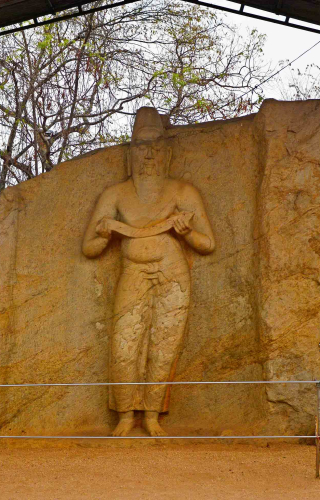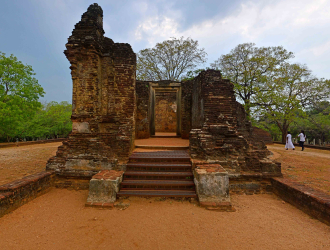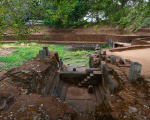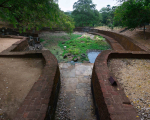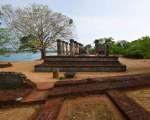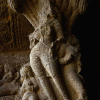Indian history is usually studied within the confines of its current borders and what is present-day Pakistan and Bangladesh, countries which were a contiguous part of undivided India before 1947. Being an island country, Sri Lanka is usually not included in the territorial history of the subcontinent. Though geographically separate from India, Sri Lankan history is deeply entangled with Indian history, best reflected in the Polonnaruwa period (eleventh to thirteenth centuries CE).
From the arrival of Prince Vijaya from Kalinga (modern Odisha) to the introduction of Buddhism and the establishment of many ruling dynasties, epochal events in Sri Lankan history can be linked to events in India or may be a result of Indian involvement in Sri Lanka. Unlike Northern India, which faced repeated invasions from the north-west and was ruled by dynasties for relatively shorter time spans, southern India was protected by the sea on three sides and, till the fourteenth century, was rarely invaded from north India. Hence stable kingdoms emerged in the deep south, which ruled for much longer durations.
The Tamil country was divided between three great dynasties—the Cholas, the Cheras, and the Pandyas. In the Edicts of Ashoka they are collectively referred to as Muventhar (Three Glorified by Heaven). Sri Lanka, due to its proximity to India, had no choice but be a participant in the regional power games. Through a policy of intermarriage with Indian princesses and strategic alliances, Sri Lanka was able to maintain its independence. Anuradhapura was its capital city for 1,400 years, and flourished as a great centre of learning in the Buddhist world.
Anuradhapura’s alliance with the Pandyas—rival to the Cholas—served as casus belli for an invasion by Rajaraja Chola I (r. 985–1014 CE) in 993 CE. The Cholas sacked Anuradhapura, forcing the ruling dynasty to seek refuge further south, at Ruhunu. Rajaraja I’s successor, Rajendra Chola I (r. 1014–44 CE) expanded Chola rule throughout Sri Lanka, incorporating Ruhunu. He imprisoned the last king, Mahinda V, and his family and exiled them to India.
With the destruction of Anuradhapura, the Cholas sought a new power base at a former military outpost, which marked the beginning of the period of Sri Lanka’s second capital at Polonnaruwa. The Cholas built some Hindu temples at Polonnaruwa, but their influence didn’t last because they couldn’t consolidate their hold over Ruhunu, where a resistance movement against Chola occupation was kept alive. The insurgency turned into a prolonged war of attrition of raids and counter-raids, gradually eroding Chola fortitude.
Sinhalese resistance was finally successful in 1070 CE, when Anuradhapura and Polonnaruwa were recaptured by Vijayabahu I (r. 1072–1110 CE). He crowned himself king at Anuradhapura but continued to maintain his capital at Polonnaruwa. Following a tradition of political marriage alliances, Vijayabahu I took two Indian queens: Trilokasundari from Kalinga, and Lilavati from Kannauj. These two regions were powerful kingdoms in northern and eastern India, respectively, who could form a coalition with Sri Lanka against the southern powers.
Though Vijayabahu I opposed the Cholas, there is evidence his army recruited Tamil troops from India. His reign was abruptly interrupted in 1084 CE by the Vellakkara revolt when the Vellakara, who were Tamil mercenaries, refused to fight fellow Tamils in the Chola armies. At Polonnaruwa, a stele declares the Vellakara as eternal protectors of the Temple of the Tooth. Vijayabahu I was successful in putting down the rebellion by executing the rebel leaders but, after his death, his successors were preoccupied by internal strife.
After incessant civil wars, Parakramabahu I (r. 1153–86 CE) unified Sri Lanka under his political authority, ushering in Polonnaruwa’s ‘Golden Age’. He constructed several irrigation projects, most impressive of which is the massive reservoir named after him, Parakrama Samudra. Many monuments at Polonnaruwa date from his reign, including the Sacred Quadrangle which housed the tooth relic and alms bowl of the Buddha. Parakramabahu I also built other Buddhist monuments like the Gal Vihara, Lankatilaka, Tivanka and Thubarama.
Reversing centuries of Indian intervention in Sri Lankan affairs, Parakramabahu I extended his military influence in India by capturing Rameshwaram and sending troops under his general Lankapura to defend the Pandya King Parakrama Pandyan I and his son, Vira Pandya, in the Pandyan Civil War (1169–77 CE). Though he raised the prestige of Sri Lanka, in the process, Parakramabahu I exhausted his kingdom’s resources. His war campaigns and ambitious building projects came at enormous cost to the treasury, raised by high rates of taxation.
Soon after Parakramabahu I’s death, his dynasty was ended by Nissanka Malla (r. 1187–96 CE), who claimed lineage from Prince Vijaya, the legendary founder of Sri Lanka. Because Prince Vijaya was exiled from Kalinga (modern Odisha), the dynasty founded by Nissanka Malla came to be known as the House of Kalinga. Nissanka Malla declared that only a Buddhist can be the sovereign ruler of Sri Lanka, and made new Buddhist constructions at Polonnaruwa like the Lata Mandapa, Gal Pota, Hatadage and Rankot Vihara.
Following Nissanka Malla’s death, Polonnaruwa descended into anarchy. Intermittently, power was held by Queen Lilavati (r. 1197–1200 CE, 1209–10 CE and 1211–12 CE), wife of Parakramabahu I, and Queen Kalyanavati (r. 1202–08 CE), wife of Nissanka Malla. Queen Lilavati's life and reigns spanned the final decline of Sinhalese power in Polonnaruwa. The twenty-six years following her husband's death saw nine separate rulers and at least three invasions from the Chola and Pandya kingdoms. In 1212 CE, led by Parakrama Pandyan II, Sri Lanka was again invaded and Queen Lilavati was overthrown for a last and final time.
Within three years, another invasion from India, led by Kalinga Magha, landed near Jaffna and moved upcountry to Polonnaruwa, deposing Parakrama Pandyan II. To establish his legitimacy, Kalinga Magha claimed origin from Kalinga, or may have been related to earlier rulers. Infamous for his tyranny, he destroyed Buddhist monuments and, fearing his excesses, the sacred tooth relic and alms bowl of the Buddha had to be buried. Another protracted insurgency by the Sinhalese ousted Kalinga Magha in 1236 CE and he retreated to Jaffna.
Unable to repel repeated invasions, Vijayabahu III (r. 1220–24 CE) shifted the capital to Dambadeniya in south-central Sri Lanka. The sacred tooth relic and alms bowl of Buddha, which was hidden earlier, was recovered and enshrined in a new temple. Though an attempt was made by Parakramabahu III (r. 1302–10 CE) to make a return, Polonnaruwa was deemed indefensible and permanently abandoned. Thereafter, the capital never returned north to the Rajarata region. Polonnaruwa was rediscovered covered in foliage in the 1860s and, in 1890, the Archaeological Department was established to carry out restoration of the site. In 1982, the ancient city of Polonnaruwa was designated a World Heritage Site by UNESCO.
Bibliography
Coedes, George. The Indianized States of South East Asia. Edited by Walter F. Vella and translated by Susan Brown Cowing. Honolulu: East-West Center Press,1968.
Dabral, Virender K. Buddhist Art in India and Sri Lanka: 3rd century BC to 6th century AD: A Critical Study. New Delhi: D.K. Printworld, 2000.
Pande, Anupa, and Parul P. Dhar. Cultural Interface of India with Asia: Religion, Art and Architecture. New Delhi: D.K. Printworld & National Museum Institute, 2004.
